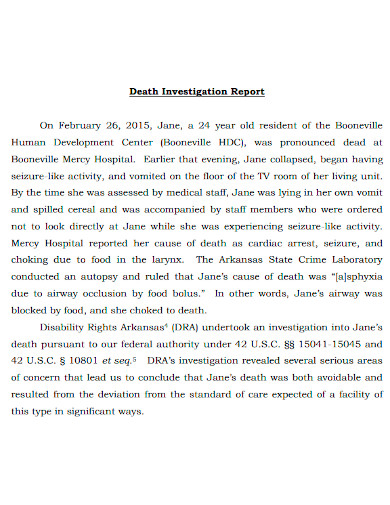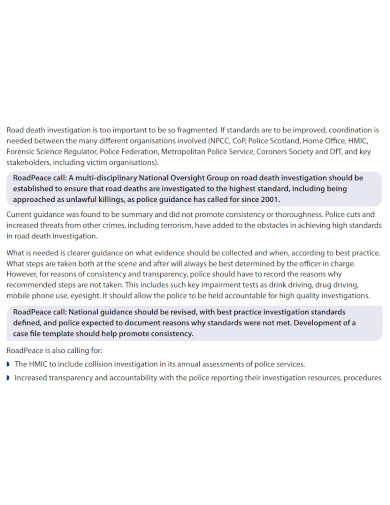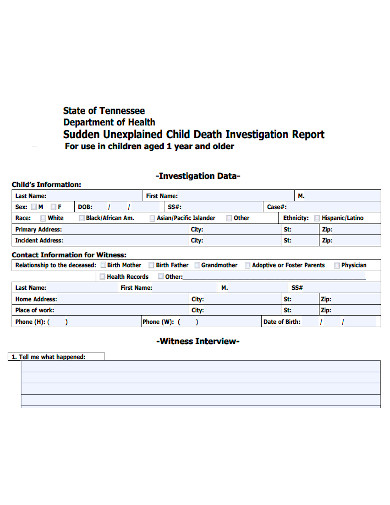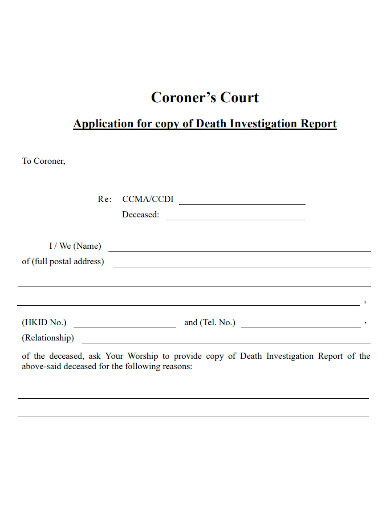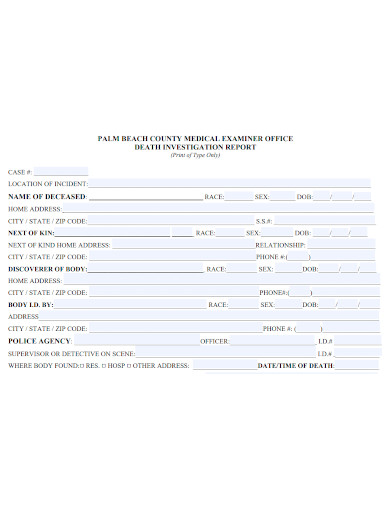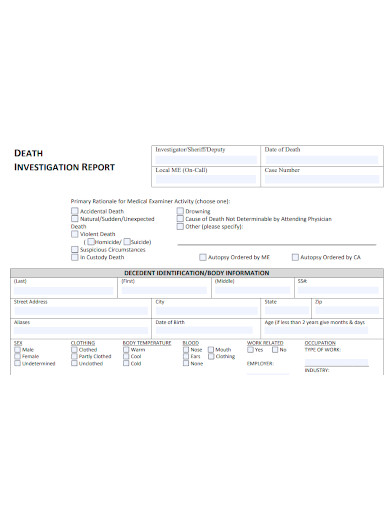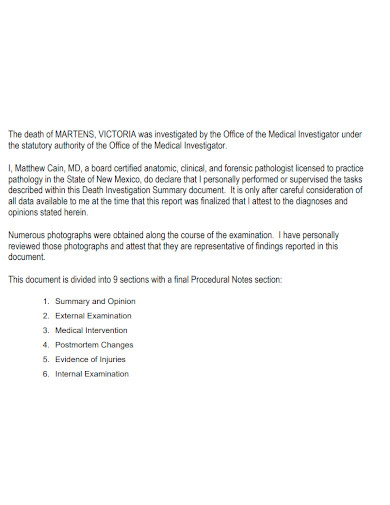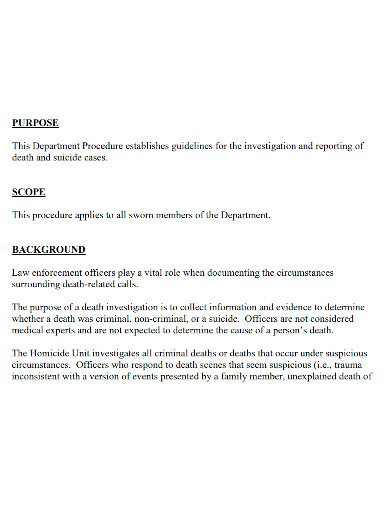Death is an inevitable process, as this is what we call the circle of life. The beginning is the day we are born and towards the end which is death. Morbid as it sounds, it is something inescapable. For years, whenever someone passes away whether this is because of natural causes, an accident or a homicide a death investigation is always underway. This is to ensure any bereaved family members, relatives or acquaintances of the exact cause of death and if any foul play was involved. This investigation is then summarize into a death investigation report to properly outline the conclusion or findings. To know more about death investigation reports, do continue reading this article and check out our free death investigation report samples below:
7+ Death Investigation Report Samples
1. Death Investigation Report Sample
2. Road Death Investigation Report
3. Child Death Investigation Report
4. Death Investigation Report Copy Application
5. Death Investigation Report Format
6. Standard Death Investigation Report
7. General Death Investigation Report
8. Professional Death Investigation Report
What Is a Death Investigation Report?
After a thorough examination usually done by a medical examiner, pathologist or a coroner he or she would present the findings in what we call a Death Investigation Report. This a summary of the facts and circumstances surrounding a decedent’s death. Includes biographical data and may include references to other investigative agencies including law enforcement–if the cause of death are deemed as suspicious which may progress to a homicide investigation report. As this a sensitive matter, death investigation reports must be written based on the facts presented and must be done meticulously.
How to Write a Death Investigation Report?
For many individuals the death of a loved one is just such a crisis. Ensuring that the proper steps and procedures are taken at the scene of that death to reassure family members that the death was a natural one, a suicide, or a homicide. After which the death investigation report must done properly without missing some detail and coming to the wrong conclusions, it must be methodical and guided by a steady hand.
I. Decedent Information
This should contain basic information about the victim or decedent as to properly document the process. These information are as follows:
- Name
- Address
- Gender and Physical Attributes
- Date of Birth and Age
- Marital Status
- Family Information
- Ethnicity and Race
To add if applicable are the education and employment status.
II. Secondary Parties
Collect information about the first person(s) to discover the decedent or whoever identified the victim. Their relationship and how was the deceased singled out. Include information about the next of kin–this is a person’s closest living blood relative. Lastly state if there are any other witnesses to the death, include any personal information and witness statement in the report.
III. Scene/Incident Information
This is one of the most important portion of the investigation report as this will contain crucial information that can help other investigative agencies and law enforcements. Information gathered in this portion of the report will be based or corelated by the initial findings of crime scene investigators or any professional this could be someone part of a medical team who was present during the initial discovery of the deceased. Below are the data to be included in this report:
- Time and Place of Death
- Those present on the scene, if there were any medics or policemen
- Describe how the injury occurred: include information about any other individuals who were involved and their role in the incident, where the injury occurred and a general narrative of the sequence of events leading up to the incident.
IV. Circumstance Surrounding Death
The cause of death is the specific injury or disease that lead to the demise. Determine how or what injury or disease caused the death. Here are some details to consider:
- Work related incident or accident
- Was the decedent in custody?
- Was the injury related to domestic violence?
- Evidence of drugs or alcohol
- Involvement of medical malpractice
V. Investigation Process
Describe and gather all the evidences collected such as medical reports, medical history of the deceased, firearms or weapons, syndromes recognize during autopsy, forensic findings and other relevant components related to the possible cause of death.
VI. Cause of Death
With the evidences to support the investigation, determine and describe the cause of death. Keep it detailed as possible, you can use body diagrams or visual inspection to further explain the manner of death and add any narrative or comments in your report.
FAQs
What Is a Forensic?
Forensic is the application of scientific methods and techniques in a legal setting. An example of which is DNA profiling, fingerprints and bloodstain patterns.
What Is Medicolegal Death?
These are classified as unexpected, sudden or violent deaths that are in need of a formal or official investigation.
What Is a Criminal Investigation?
A criminal investigation is a process which involves the study of facts that are then used to inform criminal trials. Information is collected to determine if a crime has been committed, identify the perpetrator; apprehend the perpetrator and then provide evidence to support a conviction in court.
Overall, a detailed and complete death investigation reports could constitute closure to the bereaved family and friends of the deceased. This could also help with any police related investigations for suspicious related deaths or address any medical or environmental concerns. Which can be used in the future for reference and evidence that can help solve issues.
Related Posts
FREE 19+ Sample Funeral Program Examples
FREE 12+ Sample Funeral Invitation Templates
FREE 10+ Affidavit of Funeral Expenses Samples
FREE 9+ Medical Note Samples
FREE 8+ Patient Note Samples
FREE 7+ Sample Useful Condolence Letter Templates
FREE 6+ Sample Medical Certification Forms
FREE 5+ Sympathy Message Templates
FREE How to Write an Obituary
FREE 42+ Sample Claim Forms
FREE 15+ Printable Obituary Templates
FREE 10+ Affidavit of End-Use/Ownership Samples
FREE 8+ Sample Notify Letter Templates
FREE 7+ Sample Inform Letter Templates
FREE How to Write a Funeral Program Obituary with the Use of ...

